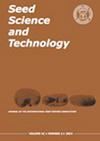黄瓜种子的休眠行为及破休眠方法的有效性
IF 3
4区 农林科学
Q2 AGRONOMY
引用次数: 0
摘要
研究了不同破休眠处理对黄瓜种子的休眠行为及破休眠效果。以新鲜收获的CU-1047和CU-1051黄瓜种子为原料,提取、干燥、常温保存8周。每两周进行一次激素分析(ABA, GA, zeatin和kinetin)。在第二个实验中,使用干热处理(DHT)在36、50或80°C下进行不同时间长度的休眠打破方法。化学处理也进行了测试,用GA3、KNO3或超细气泡(UFB)水浸泡24小时。结果表明,两个品种的种子收获后休眠持续时间均为3周,萌发率达85%以上。贮藏期ABA含量的降低与种子发芽率的增加有关。与对照(1%)相比,80℃干热24小时(最高发芽率62%)和DHT室(59%)是打破休眠最有效的方法。另一种方法是将种子浸泡在1%的KNO3中,然后干燥到初始含水量(萌发率55%)。UFB水对打破黄瓜种子休眠没有效果。本文章由计算机程序翻译,如有差异,请以英文原文为准。
Dormancy behaviour and effectiveness of dormancy breaking methods in cucumber seeds (Cucumis sativus)
This study aimed to examine the dormancy behaviour and effectiveness of various dormancy breaking treatments on cucumber seeds. Freshly harvested cucumber seeds of varieties CU-1047 and CU-1051 were extracted, dried and stored for eight weeks at ambient temperature. The stored seed lots were tested for seed germination once a week and hormone analysis (ABA, GA, zeatin and kinetin) every two weeks. In a second experiment, dormancy breaking methods using dry heat treatment (DHT) at 36, 50 or 80°C for various lengths of time. Chemical treatments were also tested, with a 24-hour soaking time using GA3, KNO3 or ultra-fine bubble (UFB) water. The results showed that the dormancy persistence in both varieties was three weeks after the seeds were harvested, by which time germination reached more than 85%. The decrease in ABA content during the storage period correlated with an increase in seed germination. The most effective methods of breaking dormancy were dry heat at 80°C for 24 hours (highest germination: 62%) and a DHT chamber (59%) compared with control (1%). An alternative method was soaking the seeds in 1% KNO3 followed by drying to the initial moisture content (55% germination). UFB water was not effective in breaking the dormancy of cucumber seeds.
求助全文
通过发布文献求助,成功后即可免费获取论文全文。
去求助
来源期刊

Seed Science and Technology
农林科学-农艺学
CiteScore
3.00
自引率
28.60%
发文量
36
审稿时长
>36 weeks
期刊介绍:
Seed Science and Technology (SST) is an international journal featuring original papers and articles on seed quality and physiology related to seed production, harvest, processing, sampling, storage, genetic conservation, habitat regeneration, distribution and testing. A journal that meets the needs of researchers, advisers and all those involved in the improvement and technical control of seed quality. Published every April, August and December.
 求助内容:
求助内容: 应助结果提醒方式:
应助结果提醒方式:


